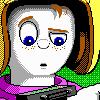Sonic Generations (PC) review"Generations is almost like two games tied by the storyline, but if a less pedantic way of implementing both of these can be found, then the blue hedgehog has a bright future ahead. For now, this is the return that Sonic needed." |
If Sonic the Hedgehog was a sports team he would be Liverpool Football Club. They have a rich history of league and European titles, but have become also-runs in the last twenty years with few trophies. Sonic is still best remembered from his Mega Drive days, but the cancellation of Sonic X-treme on the Saturn triggered over a decade of rot. Sonic Adventure helped the European Dreamcast launch in 1999 but the next-generation gloss soon faded on what was a patchy platformer. Sonic Heroes was Sega's first Sonic game since exiting the console industry but didn't reverse the decline. The 2006 Sonic The Hedgehog release and Shadow the Hedgehog destroyed the franchises remaining credibility.
Following a sports team rests on hope over statistical likelihood. Similarly I have no rational reason to follow a character that has spent over a decade in the doldrums, only that I grew up with it on the Mega Drive. The handheld Sonic Advance and Sonic Rush were rare bright spots, and Sonic Unleashed showed signs of progress. Sonic Colours, restricting the playable character roster to just Sonic, using a linear level system and polishing the camerawork, finally made for a decent 3D Sonic game at last. Sonic Generations had some momentum to build on but had to prove it wasn't a blip.
As Sonic celebrates his twentieth birthday, the Time Eater crashes the party and disperses his friends to various stages in history. Sonic is knocked out after futily taking on the monster. He wakes up in the White Space dimension and encounters Tails, as well as his plumper, black-pupiled younger self. The two Sonics have to free their friends in two different versions of levels that have emerged over the years, and eventually defeat the monster summoned by Dr. Eggman. Modern Sonic utilises the game mechanics used in 3D games like Adventure and Colours. His homing attack allows him to lock-on to an enemy when he jumps at them and can boost through levels for additional speed. Classic Sonic handles the traditional side-scrolling levels, sporting the ability to spin-dash. Levels run at a slower pace as they require some more caution, and he canít auto aim at enemies or jump as far, although some pace has been injected back into him after the sluggish Sonic the Hedgehog 4: Episode 1. Each zone in the game features an act accommodating both.
Generations is something of a healthy montage of what comprised the first twenty years of Sonic games. The nine stages are all throwbacks from three console eras. Three zones from the heights of the ĎClassic Eraí have been lovingly reimagined, including the signature Green Hill. The 'Dreamcast Eraí touches up Adventureís Speed Highway and City Escape plus Sunside Beach from the later Heroes. The ĎModern Eraí even revitalises Crisis City from the disastrous 2006 reboot, as well as Rooftop Run and Planet Wisp from Unleashed and Colours. Boss fights are dispersed between each era, but can only be unlocked upon completion of three side missions. These are usually comprised of another objective within a level, such as a ghost race or collecting items. Some are fun and others are less so, but arenít a necessity to reach the end. Similarly to secret special stages in the originals, hidden stars encourage exploration of the multiple paths in each level.
Generations may be a tribute to past games, but with some levels being 16-bit overhauls and others reinventions salvaged from mediocre games, this is far from a greatest hits compilation. The mechanics that actually made the 3D games fun such as the speed dashing, the homing attacks and the platform jumping are well-implemented, without the hindrances like unnecessary characters, poor camerawork and hub levels. Certain stretches are certainly thrilling to play through, such as the adrenalin-induced car chases and scripted environmental destruction, but the frequent handrailing does reduce the challenge to correctly timing a jump or dodging an obstacle. The side-scrolling elements in both the classic and modern zone supplement the difficulty, but it does show that 3D Sonic can only do so much without being painful to control, as has been in the past and very occasionally here. The mix of ostentatious but handrailed sequences, and 2D exploration makes the best of a formula that has been very finicky to get right.
Generations is almost like two games tied by the storyline, but if a less pedantic way of implementing both of these can be found, then the blue hedgehog has a bright future ahead. For now, this is the return that Sonic needed. Itís not the longest, and extra side missions do pad things out, but this easily matches its 16-bit games for enjoyment. The visuals are gorgeous, and just a few leaps of faith are a thorn in otherwise solid level design. The return of past characters, references and soundtracks add further nostalgia for fans from all eras to enjoy. While itís unlikely Sonic can overtake his former rival Mario, at least heís closing in terms of quality.
 |  |  |  |  |
Community review by bigcj34 (January 07, 2013)
Cormac Murray is a freelance contributor for HG and is a fanboy of Sega and older Sony consoles. For modern games though he pledges allegiance to the PC Master Race, by virtue of a MacBook running Windows. |
|
More Reviews by bigcj34 [+]
|
|
If you enjoyed this Sonic Generations review, you're encouraged to discuss it with the author and with other members of the site's community. If you don't already have an HonestGamers account, you can sign up for one in a snap. Thank you for reading!
User Help | Contact | Ethics | Sponsor Guide | Links







